Abstract
Two groups of schoolchildren between seven and 12 years old residing in the vicinity of a non-ferrous industrial plant and exposed to lead (Pb) at a concentration that could cause health problems, were monitored. Concentrations of Pb in blood (blood-Pb), which were determined at regular six monthly intervals, were related to the Pb concentrations in surface tooth enamel (enamel-Pb). Acid etch biopsy samples of surface enamel were taken at the end of the five year study period in the first group (A) and after two years in the second group (B). Salivary Pb (saliva-Pb) concentrations were determined for the first study group on the same day that the enamel biopsies were performed. Calibration of the data was necessary--that is, blood-Pb concentration with respect to age and sex and enamel-Pb concentration with respect to etch depth and age. The blood-Pb concentrations declined with time. Surface enamel Pb concentrations correlated with blood-Pb concentration for the period starting with the pre-eruptive development of the incisors, related to blood-Pb concentration for a long time, and corresponded partly to the exposure at the time of pre-eruptive development and/or eruption. Through the correlation with enamel-Pb concentration, the seasonal behaviour of blood-Pb concentration became apparent. Saliva-Pb concentrations related to blood-Pb concentrations only in the short term.
Full text
PDF
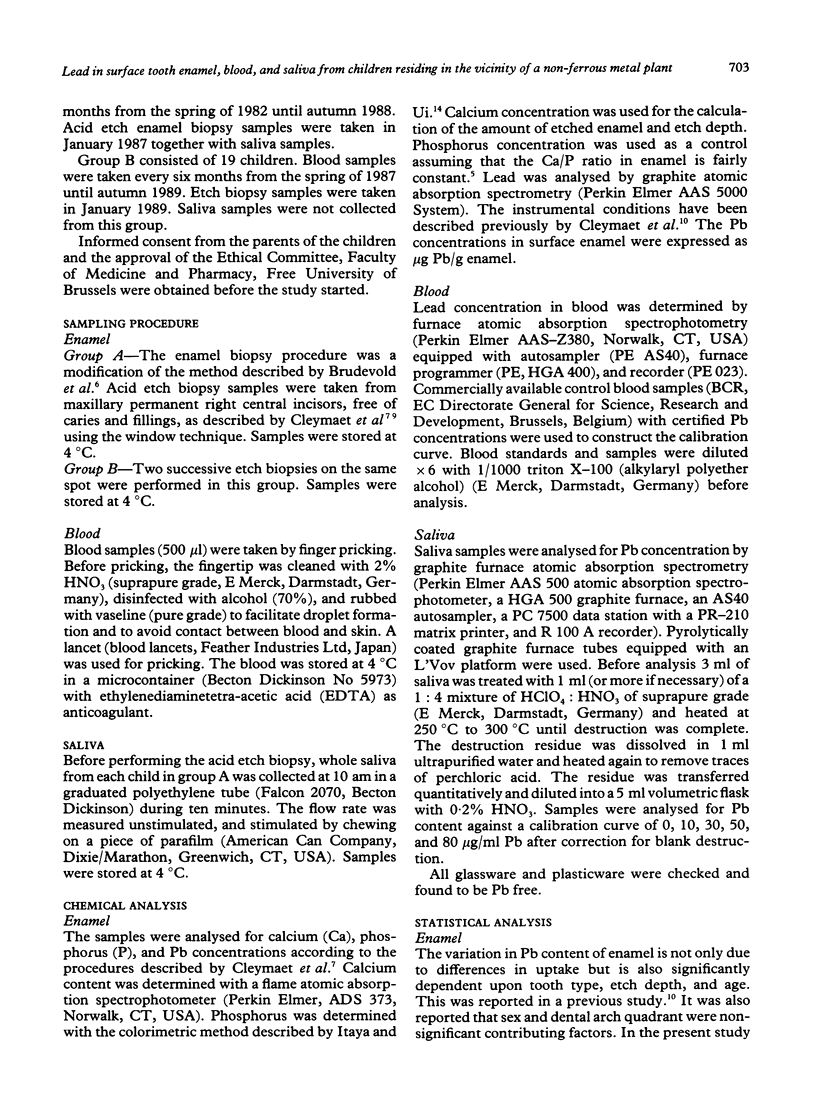

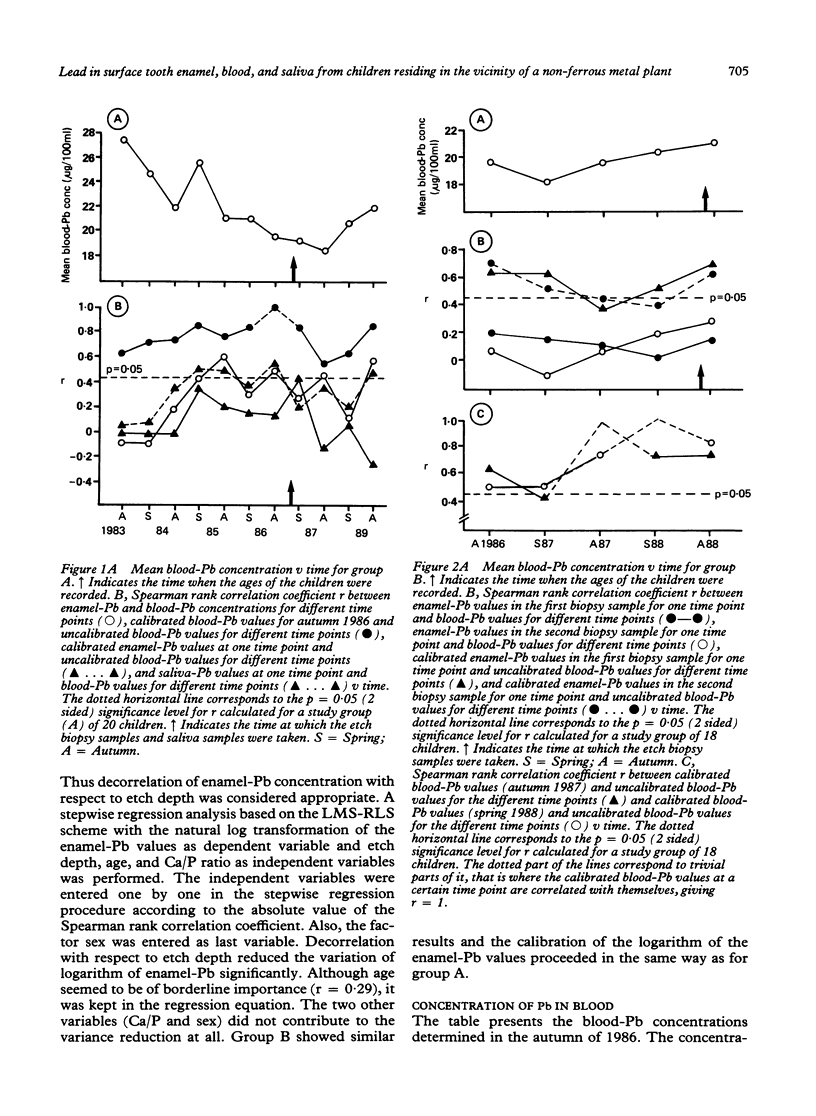
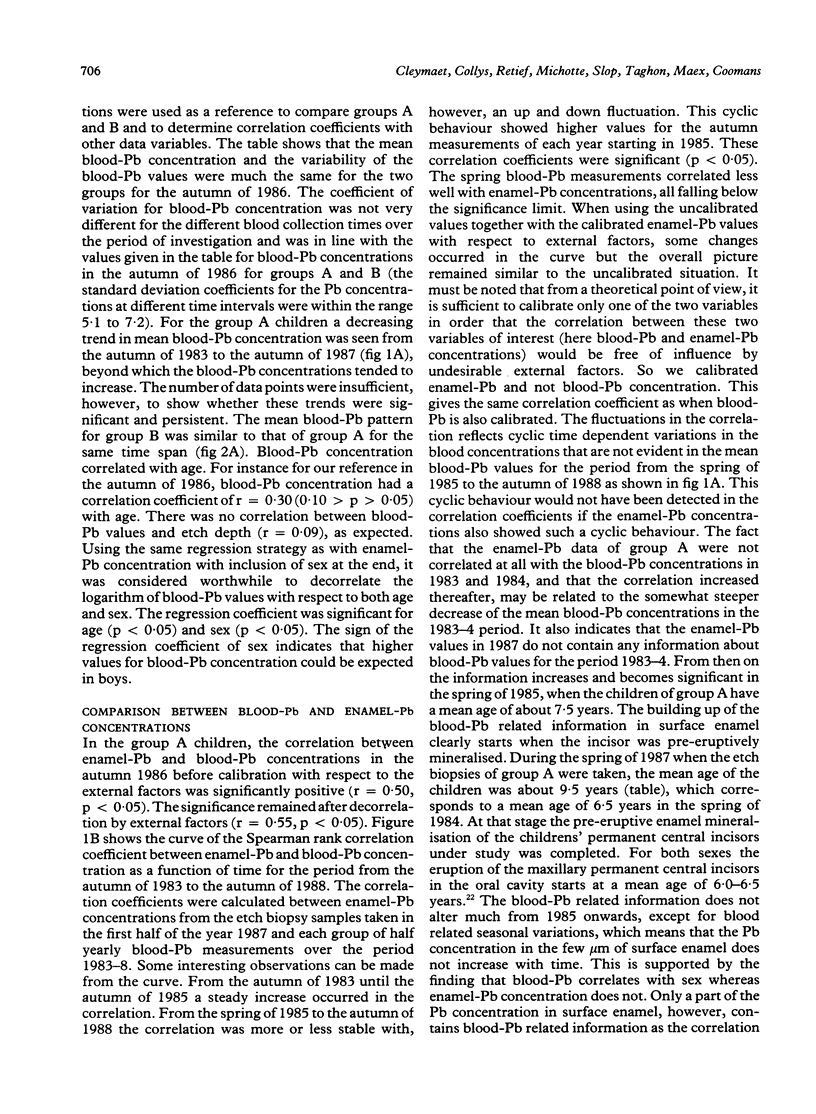
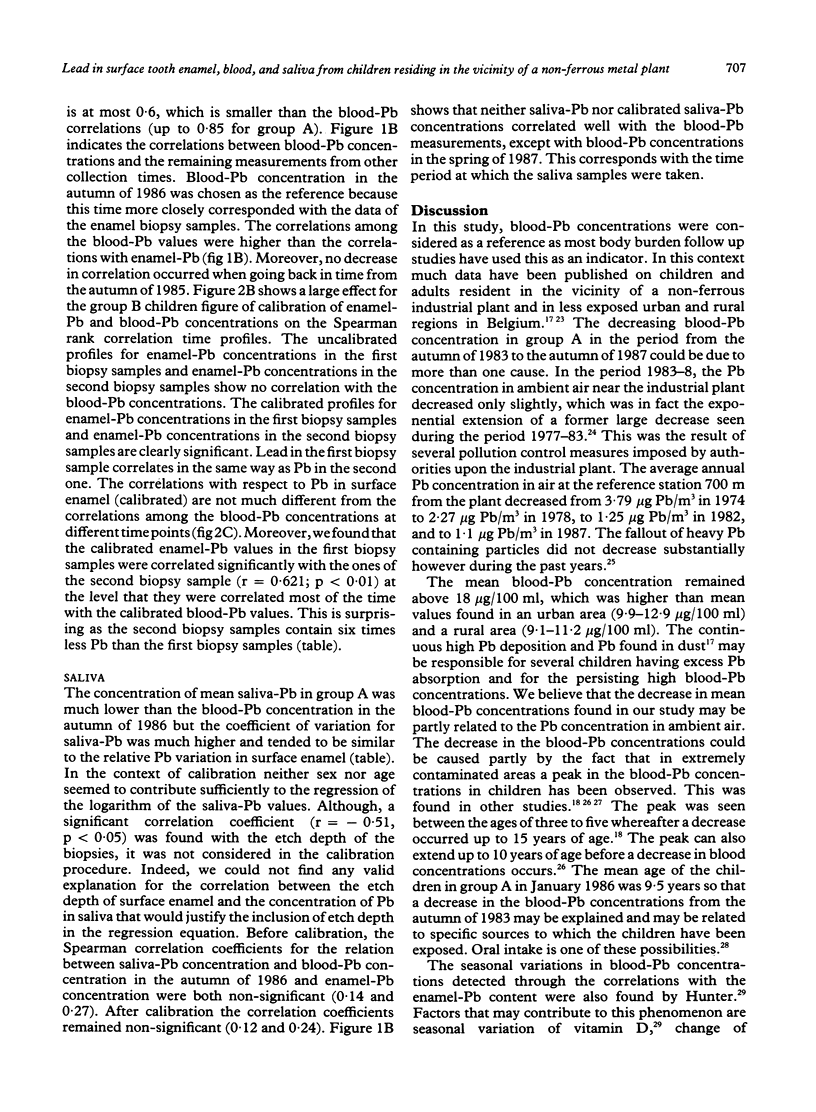

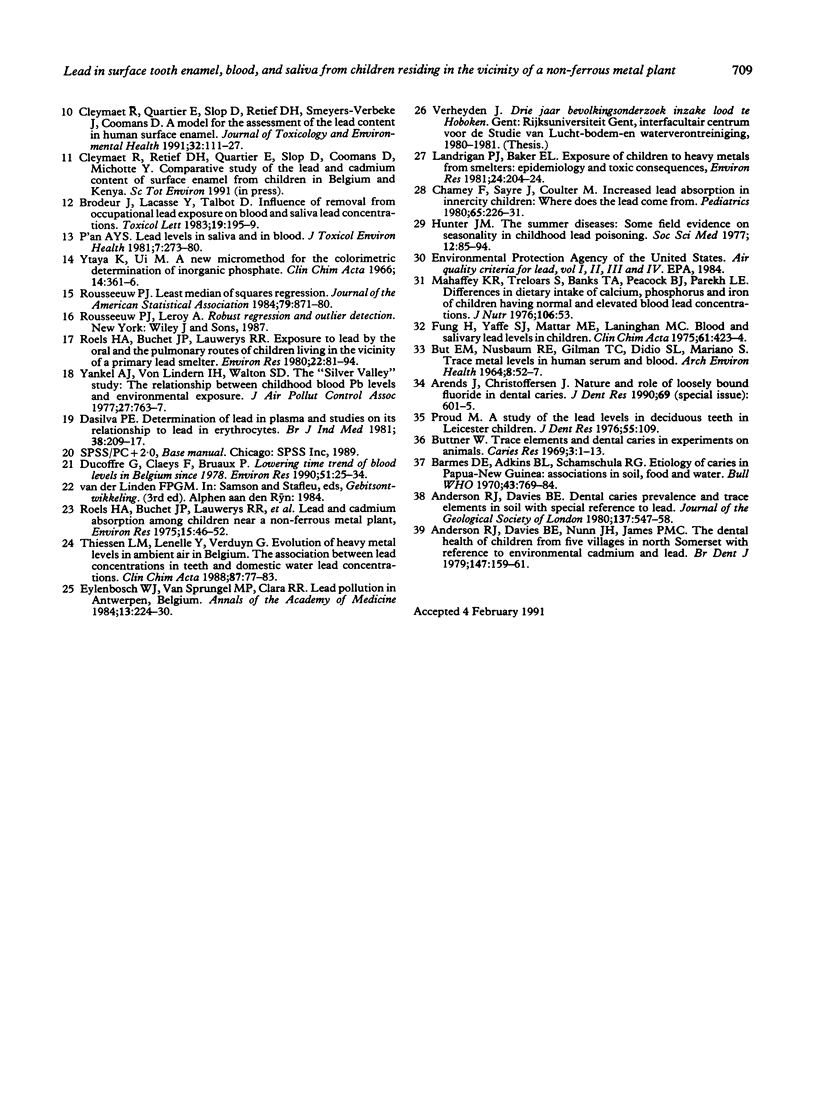
Selected References
These references are in PubMed. This may not be the complete list of references from this article.
- Anderson R. J., Davies B. E., Nunn J. H., James P. M. The dental health of children from five villages in North Somerset with reference to environmental cadmium and lead. Br Dent J. 1979 Sep 18;147(6):159–161. doi: 10.1038/sj.bdj.4804309. [DOI] [PubMed] [Google Scholar]
- Arends J., Christoffersen J. Nature and role of loosely bound fluoride in dental caries. J Dent Res. 1990 Feb;69(Spec No):601–636. doi: 10.1177/00220345900690S118. [DOI] [PubMed] [Google Scholar]
- BUTT E. M., NUSBAUM R. E., GILMOUR T. C., DIDIO S. L., SISTER MARIANO TRACE METAL LEVELS IN HUMAN SERUM AND BLOOD. Arch Environ Health. 1964 Jan;8:52–57. doi: 10.1080/00039896.1964.10663631. [DOI] [PubMed] [Google Scholar]
- Barmes D. E., Adkins B. L., Schamschula R. G. Etiology of caries in Papua-New Guinea. Associations in soil, food and water. Bull World Health Organ. 1970;43(6):769–784. [PMC free article] [PubMed] [Google Scholar]
- Brodeur J., Lacasse Y., Talbot D. Influence of removal from occupational lead exposure on blood and saliva lead concentrations. Toxicol Lett. 1983 Oct-Nov;19(1-2):195–199. doi: 10.1016/0378-4274(83)90282-5. [DOI] [PubMed] [Google Scholar]
- Brudevold F., Aasenden R., Srinivasian B. N., Bakhos Y. Lead in enamel and saliva, dental caries and the use of enamel biopsies for measuring past exposure to lead. J Dent Res. 1977 Oct;56(10):1165–1171. doi: 10.1177/00220345770560100701. [DOI] [PubMed] [Google Scholar]
- Brudevold F., Reda A., Aasenden R., Bakhos Y. Determination of trace elements in surface enamel of human teeth by a new biopsy procedure. Arch Oral Biol. 1975 Oct;20(10):667–673. doi: 10.1016/0003-9969(75)90135-1. [DOI] [PubMed] [Google Scholar]
- Büttner W. Trace elements and dental caries in experiments on animals. Caries Res. 1969;3(1):1–13. doi: 10.1159/000259586. [DOI] [PubMed] [Google Scholar]
- Charney E., Sayre J., Coulter M. Increased lead absorption in inner city children: where does the lead come from? Pediatrics. 1980 Feb;65(2):226–231. [PubMed] [Google Scholar]
- Cleymaet R., Bottenberg P., Slop D., Clara R., Coomans D. Study of lead and cadmium content of surface enamel of schoolchildren from an industrial area in Belgium. Community Dent Oral Epidemiol. 1991 Apr;19(2):107–111. doi: 10.1111/j.1600-0528.1991.tb00122.x. [DOI] [PubMed] [Google Scholar]
- Cleymaet R., Quartier E., Slop D., Retief D. H., Smeyers-Verbeke J., Coomans D. Model for assessment of lead content in human surface enamel. J Toxicol Environ Health. 1991 Feb;32(2):111–127. doi: 10.1080/15287399109531472. [DOI] [PubMed] [Google Scholar]
- Curzon M. E., Crocker D. C. Relationships of trace elements in human tooth enamel to dental caries. Arch Oral Biol. 1978;23(8):647–653. doi: 10.1016/0003-9969(78)90189-9. [DOI] [PubMed] [Google Scholar]
- Ducoffre G., Claeys F., Bruaux P. Lowering time trend of blood lead levels in Belgium since 1978. Environ Res. 1990 Feb;51(1):25–34. doi: 10.1016/s0013-9351(05)80180-x. [DOI] [PubMed] [Google Scholar]
- Eylenbosch W. J., van Sprundel M. P., Clara R. R. Lead pollution in Antwerpen, Belgium. Ann Acad Med Singapore. 1984 Apr;13(2):224–230. [PubMed] [Google Scholar]
- Fung H. L., Yaffe S. J., Mattar M. E., Lanighan M. C. Blood and salivary lead levels in children. Clin Chim Acta. 1975 Jun 20;61(3):423–424. doi: 10.1016/0009-8981(75)90436-2. [DOI] [PubMed] [Google Scholar]
- Hunter J. M. The summer disease. Some field evidence on seasonality in childhood lead poisoning. Soc Sci Med. 1978 Jun;12(2D):85–94. doi: 10.1016/0037-7856(78)90002-1. [DOI] [PubMed] [Google Scholar]
- Itaya K., Ui M. A new micromethod for the colorimetric determination of inorganic phosphate. Clin Chim Acta. 1966 Sep;14(3):361–366. doi: 10.1016/0009-8981(66)90114-8. [DOI] [PubMed] [Google Scholar]
- Landrigan P. J., Baker E. L. Exposure of children in heavy metals from smelters: epidemiology and toxic consequences. Environ Res. 1981 Jun;25(1):204–224. doi: 10.1016/0013-9351(81)90090-6. [DOI] [PubMed] [Google Scholar]
- Maresky L. S., Grobler S. R. Unusually high circumpulpal lead concentrations as valid evidence of lead intoxication. Hum Toxicol. 1987 Nov;6(6):475–477. doi: 10.1177/096032718700600604. [DOI] [PubMed] [Google Scholar]
- Needleman H. L., Gunnoe C., Leviton A., Reed R., Peresie H., Maher C., Barrett P. Deficits in psychologic and classroom performance of children with elevated dentine lead levels. N Engl J Med. 1979 Mar 29;300(13):689–695. doi: 10.1056/NEJM197903293001301. [DOI] [PubMed] [Google Scholar]
- P'an A. Y. Lead levels in saliva and in blood. J Toxicol Environ Health. 1981 Feb;7(2):273–280. doi: 10.1080/15287398109529978. [DOI] [PubMed] [Google Scholar]
- Roels H. A., Buchet J. P., Lauwerys R. R., Bruaux P., Claeys-Thoreau F., Lafontaine A., Verduyn G. Exposure to lead by the oral and the pulmonary routes of children living in the vicinity of a primary lead smelter. Environ Res. 1980 Jun;22(1):81–94. doi: 10.1016/0013-9351(80)90121-8. [DOI] [PubMed] [Google Scholar]
- Yankel A. J., von Lindern I. H., Walter S. D. The Silver Valley lead study: the relationship between childhood blood lead levels and environmental exposure. J Air Pollut Control Assoc. 1977 Aug;27(8):763–767. doi: 10.1080/00022470.1977.10470488. [DOI] [PubMed] [Google Scholar]
- deSilva P. E. Determination of lead in plasma and studies on its relationship to lead in erythrocytes. Br J Ind Med. 1981 Aug;38(3):209–217. doi: 10.1136/oem.38.3.209. [DOI] [PMC free article] [PubMed] [Google Scholar]
- van der Merwe E. H., Retief D. H., Barbakow F. H., Friedman M. An evaluation of an in vivo enamel acid etch biopsy technique for fluoride determination. J Dent Assoc S Afr. 1974 Feb;29(2):81–87. [PubMed] [Google Scholar]


